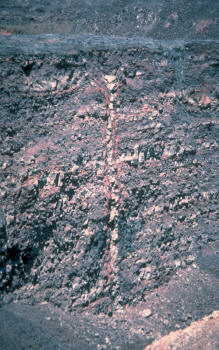dike

This dike was exposed when a new pit crater formed in about 1880 AD in the northeast corner of the summit caldera of Mauna Loa Volcano. The dike is about 1.5 meters wide. Credit: J. P. Lockwood / US Geological Survey.
A dike is a tabular or sheet-like body of igneous rock which, unlike a sill, cuts through and across the layering of adjacent rocks. Dikes (or dykes) form when magma rises into an existing fracture, or creates a new crack by forcing its way through existing rock, and then solidifies. Hundreds of dikes can invade the cone and inner core of a volcano, sometimes preferentially along zones of structural weakness.


